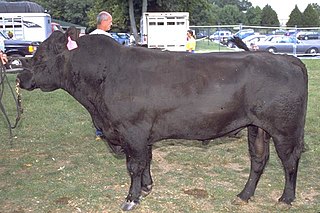
The Aberdeen Angus, sometimes simply Angus, is a Scottish breed of small beef cattle. It derives from cattle native to the counties of Aberdeen, Banff, Kincardine and Angus in north-eastern Scotland. In 2018 the breed accounted for over 17% of the UK beef industry.

Holstein Friesians are a breed of dairy cattle that originated in the Dutch provinces of North Holland and Friesland, and Schleswig-Holstein in Northern Germany. They are known as the world's highest-producing dairy animals.

The Dairy Shorthorn is a British breed of dairy cattle. It derives from the Shorthorn cattle of Tees-side, in the North Riding of Yorkshire and in Northumbria in north-eastern England. The Shorthorn was for this reason at first known as the Durham or Teeswater.

Wagyu is any of the four Japanese breeds of beef cattle.
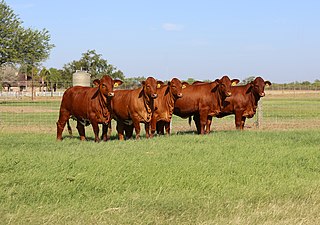
Beefmaster is a breed of beef cattle that was developed in the early 1930s by Tom Lasater, from a systematic crossing of Hereford cows and Shorthorn cows with Brahman bulls. The exact mixture of the foundation cattle is unknown, but is thought to be about 25% Hereford, 25% Milking Shorthorn and 50% Brahman. It was first recognized by the USDA as a new breed in 1954. The original intention was to produce cattle that could produce economically in the difficult environment of South Texas. The cattle were selected by using the Six Essentials – weight, conformation, milking ability, fertility, hardiness and disposition. While brownish-red is the most common color, the breed has no color standards. Over the past decade, the Beefmaster breed has become very popular among herd managers using the breed in their heterosis programs for hybrid vigor. These cattle are a versatile breed and adapt to many climates.

The Afrikaner, also known as the Africander, is a breed of taurine-indicine ("Sanga") cattle indigenous to South Africa.

The Shorthorn breed of cattle originated in the North East of England in the late eighteenth century. The breed was developed as dual-purpose, suitable for both dairy and beef production; however, certain blood lines within the breed always emphasised one quality or the other. Over time, these different lines diverged, and by the second half of the twentieth century, two separate breeds had developed – the Beef Shorthorn, and the Milking Shorthorn. All Shorthorn cattle are coloured red, white, or roan, although roan cattle are preferred by some, and completely white animals are not common. However, one type of Shorthorn has been bred to be consistently white – the Whitebred Shorthorn, which was developed to cross with black Galloway cattle to produce a popular blue roan crossbreed, the Blue Grey.
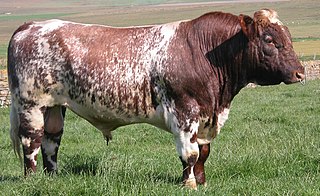
The Beef Shorthorn breed of cattle was developed from the Shorthorn breed in England and Scotland around 1820. The Shorthorn was originally developed as a dual-purpose breed, suitable for both dairy and beef production. However, different breeders opted to concentrate on one purpose rather than the other, and in 1958, the beef breeders started their own section of the herdbook. Since then, the Beef Shorthorns have been developed as a separate breed to the Dairy Shorthorns.

Luing cattle are a beef breed developed on the island of Luing in the Inner Hebrides of Scotland by the Cadzow brothers in 1947. It was formed by first crossbreeding Beef Shorthorn with Highland cattle and then breeding the resulting progeny with Beef Shorthorns to produce an animal three quarters Beef Shorthorn, one quarter Highland. The breed of red-brown cattle are moderately sized and extremely hardy. The intent was to produce a good beef cow with the ability to raise a calf under adverse weather conditions. It was officially recognised as a breed by the British government in 1965. The breed is still farmed today, mainly in Scotland but also in other areas of the world.
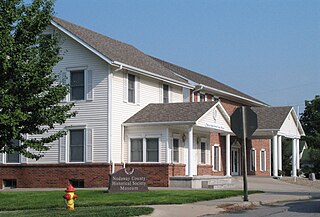
The Nodaway County Historical Society Museum is a museum in Maryville, Missouri telling the history of Nodaway County, Missouri, United States.

Leroy Kershaw (1880–1969) was an American attorney, banker, businessman, cattleman and political candidate.
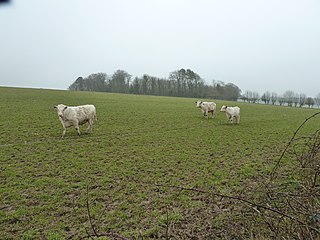
Whitebred Shorthorn is a British type of beef cattle originating in north west England and south west Scotland. It is derived from Shorthorn cattle, but is always white, rather than being the range of colours found in other Shorthorns. It has not undergone the specialisation seen in other Shorthorns, and so it remains as a more traditional hardy and thrifty cattle type. This favours its use for conservation grazing of hill pastures, grazing rank grass species to maintain a diverse flora.

The Droughtmaster is an Australian breed of beef cattle. It was developed from about 1915 in North Queensland by crossing zebuine cattle with cattle of British origin, principally the Beef Shorthorn. It was the first Australian taurindicine hybrid breed; it is approximately 50% Bos indicus and 50% Bos taurus.
Appleyard, also known as the Alexander C. Stevenson Farm, is a historic farm located on the south side of State Road 240 2 miles (3.2 km) east of Greencastle in Putnam County, Indiana. The farm was the home of Alexander Campbell Stevenson, an Indiana politician and agriculturalist. Stevenson founded the farm in 1843 while serving in the Indiana House of Representatives; he later served as speaker of the assembly. Stevenson bred shorthorn cattle and merino sheep on his farm using modern methods and became a prominent agricultural expert in Indiana. As a result of his efforts, Stevenson was appointed to Indiana's first State Board of Agriculture in 1851; during his tenure on the board, he helped establish the Indiana State Fair. Stevenson later served as president of the Indiana Shorthorn Breeders Association and the American Shorthorn Breeders Association.
Miniature cattle are found in various parts of the world. Some, such as the Dexter of Ireland and the Vechur of Kerala, India, are traditional breeds; others have been recently created by selective breeding. The Australian Lowline was the unexpected result of a scientific experiment. Some, but not all, miniature breeds display achondroplasia, or dwarfism.

The Robert Milne House is a historic residence in Lockport, Illinois, United States. It was home to Robert Milne, Canal Commissioner of the Illinois and Michigan Canal.

Thomas Icely was an early colonial New South Wales landholder and stockbreeder. As a nominee Legislative Councillor from 1843, to 1853, and from 1855, until the establishment of responsible government in 1856, he was a consistent supporter of the Governor. He served a second term as a life appointee to the Legislative Council from 1864.
Canowie or Canowie Station is a pastoral lease located about 18 kilometres (11 mi) north west of Hallett and 23 kilometres (14 mi) south west of Terowie in the state of South Australia.
Alexander Campbell Stevenson was an American farmer, physician, and politician.

The Japanese Shorthorn is a breed of small Japanese beef cattle. It is one of six native Japanese cattle breeds, and one of the four Japanese breeds known as wagyū, the others being the Japanese Black, the Japanese Brown and the Japanese Polled. All wagyū cattle derive from cross-breeding in the early twentieth century of native Japanese cattle with imported stock, mostly from Europe. In the case of the Japanese Shorthorn, the principal foreign influence was from the Shorthorn, with some contribution from the Ayrshire and Devon breeds.


















